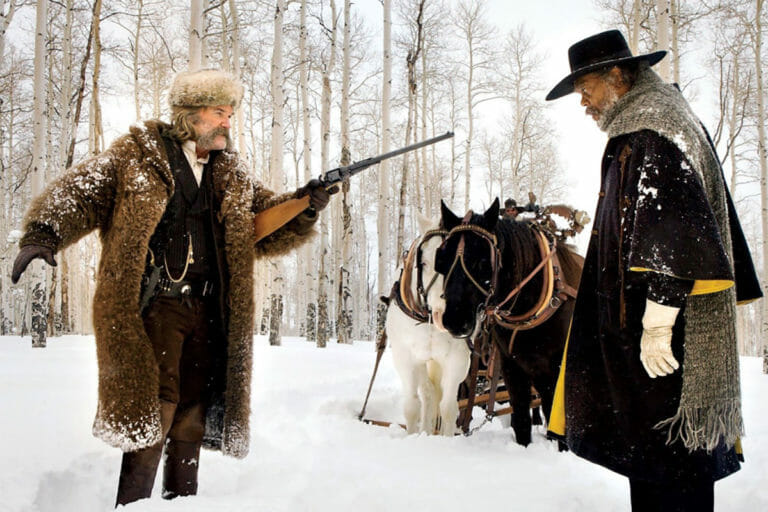Review: The Hateful Eight is Spectacle and Theater All In One
By Christopher Ortiz · January 3, 2016
Quentin Tarantino was born to make Westerns. Professors, screenwriting consultants, and industry professionals warn against writing them given their expense and waning popularity, not to mention the sheer difficulty of producing one. And yet, with few exceptions, the few that get the greenlight prove what a delight the Western can be. The clout of filmmaking veterans like James Mangold (3:10 To Yuma) and, of course, Clint Eastwood (Unforgiven) keeps the genre alive for other filmmakers to push and satirize the Western in new directions. Enter Tarantino, who has ridden in to deliver his second straight near-three hour Western spectacle. It’s another cinematic, beautiful, bloody outing from the acclaimed director, even if takes a while (well over an hour) for the juicier sequences to kick in.
So much hype over the 70mm footage and the fact that it’s a Tarantino film, but the vague trailers and relatively light marketing have left plenty wondering just what The Hateful 8 is actually about. In short, former Major Marquis Warren (Samuel Jackson), a bounty hunter in post-Civil War Wyoming, persuades John Ruth, a tactful, and ruthless bounty hunter (Kurt Russell) into giving him a ride into the town of Red Rock with his dead bounties. Ruth's got a mysterious, violent catch of his own named Daisy Domergue (Jennifer Jason Leigh) who remains cuffed to his arm at all times. The negotiation is as theatrical and suspenseful as we’d expect from Tarantino, and soon, they ride across the snowy landscapes of Wyoming together. Before long another hitchhiker asks for a ride – this time, a proud Southerner named Chris Mannix (Walton Goggins of Justified and Django Unchained), who may or may not be the new sheriff of Red Rock. Later on, they arrive at a haberdashery with a selection of other mystery men consisting of a Mexican gunslinger, an infamous hangman, and an old war general, all waiting out an intense blizzard that sweeps the landscape.
What follows is a mashup of genres – mystery, action, satire – combined with intriguing character histories and lengthy world-building dialogue. In usual Tarantino style, no one, including the supposed hero Major Marquis, is quite what they profess to be. The ways in which Tarantino explores each character through idiosyncratic dialogue and the theatrical set ups – divided into six uneven but distinct chapters – pushes “filmic theater” to new heights. Not unlike Aaron Sorkin's screenplay for Steve Jobs, The Hateful Eight could easily work as a stage play. The 70mm footage is a sight to behold in the right theater, giving a new meaning to the word “cold” during one of the film's more shocking and twisted monologues. While not as incendiary as some critics branded Django Unchained, Hateful 8 sure proves Tarantino has mastered his filmmaking craft. The vistas are crisp and the production design and Robert Richardson's cinematography do a fine job at making the haberdashery, where we spend nearly two thirds of the film's running time, feel dense but never claustrophobic.
That aside, Tarantino's usual self-indulgence does have its draw backs. A few dialogue trims in each chapter would be welcome, given that the constant back and forth robs the film of the quiet intensity you might expect from a film about untrustworthy bounty hunters and scheming outlaws. The filmmaker is admittedly master of his own form of suspense – the “talky” sort – but there’s less of that here than in Django Unchained. That’s in part due to the fact that Django was fueled by stronger thematic material than Hateful 8. The former explored 19th century racism and slavery along with its controversial use of the n-word, all of which parallel the racism of our own time. Justice, for Django, was the goal and that led to an incredibly rousing experience. Here, it’s merely survival of the fittest between the bad and the worse. So while every character is intriguing and the ensemble has great material to work with, the film’s central theme is less apparent, which feels like somewhat of a let-down given Tarantino's last couple of more themaitcally hefty films.
Despite these flaws, the near-three hour running time never feels exhausting, unlike Django, because The Hateful Eight wisely paces the film through slow, escalating tensions towards a collection of rousing and increasingly violent payoffs. The slow burn of the first hour presents the necessary build for the glorious dialogue and over-the-top violence that comes later. The ensemble, which includes Michael Madsen, Tim Roth and even Channing Tatum (who begged Tarantino for a month every single day to get his role) are fantastic. Each have motivated, intriguing characters with arcs that pay off spectacularly – specifically Major Marquis and Chris Mannix, who are initially ambivalent because of the differences in their skin color. Overall, the second Western by Quentin Tarantino poses a single question: what would happen if eight nefarious little bastards got trapped together in a blizzard? The answer is, in a word, glorious.
